- Главная
- Разное
- Дизайн
- Бизнес и предпринимательство
- Аналитика
- Образование
- Развлечения
- Красота и здоровье
- Финансы
- Государство
- Путешествия
- Спорт
- Недвижимость
- Армия
- Графика
- Культурология
- Еда и кулинария
- Лингвистика
- Английский язык
- Астрономия
- Алгебра
- Биология
- География
- Детские презентации
- Информатика
- История
- Литература
- Маркетинг
- Математика
- Медицина
- Менеджмент
- Музыка
- МХК
- Немецкий язык
- ОБЖ
- Обществознание
- Окружающий мир
- Педагогика
- Русский язык
- Технология
- Физика
- Философия
- Химия
- Шаблоны, картинки для презентаций
- Экология
- Экономика
- Юриспруденция
Lecture 1 english as a germanic language. The old english period презентация
Содержание
- 1. Lecture 1 english as a germanic language. The old english period
- 2. Plan The subject of the History of
- 3. Literature Расторгуева Т.А. История английского языка. –
- 4. Why should we learn the History of
- 5. There are approximately 7000 languages in
- 7. Indo-European family has 12 important branches: Indian,
- 8. Common Germanic branch later split up into
- 10. In the 5th c. AD some of
- 12. The English scholar Henry
- 13. The Seven Kingdoms of the Heptarchy
- 14. OLD ENGLISH DIALECTS The language is represented
- 15. Each of the periods
- 16. Word Stress in PG Due to
- 17. PIE CONSONANT SYSTEM
- 18. PG CONSONANT SYSTEM
- 20. Jacob Grimm (1785 – 1863)
- 21. Jacob Grimm and Wilhelm Grimm
- 22. The changes of consonants in PG were
- 23. The First Consonant Shift (Grimm’s Law, PG Consonant Shift)
- 24. Exceptions A PIE voiceless plosive followed the
- 25. Rus. ты – OE þu
- 26. When Grimm's law was discovered, a strange
- 27. Carl Verner (1787 – 1832) Karl
- 28. Verner’s law explains regular correspondences of consonants
- 29. Voicing of fricatives in PG (Verner’s Law)
- 30. Lat. pater – Eng. father
- 31. PIE
- 32. Verner’s law accounts for the appearance of
- 33. As a result of voicing by Verner’s
- 34. PIE VOWEL SYSTEM
- 35. PG VOWEL SYSTEM
- 36. The Common Germanic Vowelshift (1 BC –
- 37. These changes are important for us
- 38. The Germanic fracture (breaking/mutation) PIE
- 39. PG VOWEL SYSTEM
- 40. The Noun
- 41. Most nouns and adjectives in PG, and
- 42. The Adjective The Adjective agreed with the
- 43. The Verb .The majority of the verbs
- 44. STRONG AND WEAK VERBS The strong verbs
- 45. THANK YOU FOR YOUR ATTENTION!
Слайд 1KYIV NATIONAL LINGUISTIC UNIVERSITY
Subota S.V.
LECTURE 1
ENGLISH AS A GERMANIC LANGUAGE. THE
Слайд 2Plan
The subject of the History of the English Language.
PIE and Indo-European
PG and Germanic languages.
Periodization of the History of English.
Main historical events of the OE period.
Phonetic system of Germanic languages: stress, the system of consonants, the main changes (Grimm’s Law, Verner’s Law, Rhotacism).
PG Vowel system. The main changes (Common Germanic fracture, Common Germanic vowel shift).
Specific features of Common Germanic Grammar.
Слайд 3Literature
Расторгуева Т.А. История английского языка. – М.: Астрель, 2005. – С.
Ильиш Б.А. История английского языка. – Л.: Просвещение, 1972. – С. 5-8, 12-16, 20-43.
Иванова И.П., Чахоян Л.П. История английского языка. – М.: Высшая школа, 1976. – С. 5-16, 46-53.
Студенець Г.І. Історія англійської мови в таблицях. - К.: КДЛУ, 1998. – Tables 10-24,26-29
Слайд 4Why should we learn the History of the English language?
In
E.g. hit, get, but light, daughter, know or read
cut-cut-cut, but put-put-put
book-books, but man-men, foot-feet, mouse-mice,
child-children
The subject of the History of the English Language is a systematic study of the language development from the earliest times to the present day.
Слайд 5There are approximately 7000 languages in the world. Languages can
Genetically, English belongs to the Germanic group of languages, which is one of the groups of the IE language family.
Слайд 7Indo-European family has 12 important branches: Indian, Iranian, Baltic, Slavonic, Germanic,
Слайд 8Common Germanic branch later split up into three groups:
North Germanic,
West Germanic, including Old High German, Old Low German, Old Saxon, Old English and Old Frisian;
East Germanic group, represented by Gothic, Burgandian and Vandalic.
The latter three languages died and are not represented in classification of Modern Germanic languages.
Слайд 10In the 5th c. AD some of the Germanic tribes which
Old English (OE) – V (VII) – XI cc.;
Middle English (ME) – XII – XV cc. ;
New English (NE) – XVI c. – present day
Слайд 12The English scholar
Henry Sweet (1845-1912), author of a
the following division of
the history of English according to the character of vowels in unstressed positions:
OE as the period of full endings (singan),
ME as the period of leveled endings (singen),
NE as the period of lost endings (to sing).
The linguistic boundaries between the periods are very close to the important social and political events
(V c. - the settlement
of the Germanic tribes,
VII c. - earliest writings,
XI c – the Norman Conquest,
XV c. the arising of
the English nation).
Слайд 13The Seven Kingdoms
of the Heptarchy [ʹhepta:kı]
Germanic tribes formed in Britain
Слайд 14OLD ENGLISH DIALECTS
The language is represented by four dialects: Northumbrian, Mercian,
Слайд 15
Each of the periods may be characterized by specific
we have to mention, first of all, the shift of stress which took place in PG. If in PIE there were two kinds of stress - musical and dynamic, in Germanic languages only dynamic stress is preserved. In IE word stress was free and movable, in PG (and OE) it became fixed on the first syllable.
Слайд 16Word Stress in PG
Due to the force of articulation
PG *mak-oj-an
OE macian
Since the stress was fixed on the root, the weakening and loss of sounds mainly affected the affixes and grammatical endings. Many endings merged with the affixes, were weakened and dropped.
PG *fisk-a-z
Goth. fisks,
OE fisc, OI fiskr
Слайд 22The changes of consonants in PG were first formulated in terms
The essence of Grimm’s Law
The type of articulation changes while the place of articulation is unchanged.
As a result there appeared more fricatives in PG than there were in PIE.
The correspondences were grouped under 3 acts.
Each of the acts covered quite a long period of time about 100 years and more.
Слайд 24Exceptions
A PIE voiceless plosive followed the voiceless fricative [s]:
Lat. stella →
A PIE voiceless plosive followed another voiceless plosive:
Lat. octo → Goth. ahtau, Lat. captus → OHG. Haft
1. k →Χ (h) 2. t → t
p →f
Слайд 25 Rus. ты – OE þu Lat. altus → OE
PIE [t] → PG [θ] – Grimm’s Law
PIE [t] → PG [d] – ?
PIE [k] → PG [Χ] – Grimm’s Law
PIE [k] → PG [γ] – ?
Слайд 26When Grimm's law was discovered, a strange irregularity was spotted in
The PIE voiceless plosives *p, *t and *k should have changed into PG *f , *θ and *x, according to Grimm's Law. Indeed, that was known to be the usual development. However, there appeared to be a large set of words in which the agreement of Latin, Greek, Sanskrit, Baltic, Slavic etc. guaranteed PIE *p, *t or *k, and yet the Germanic reflex was voiced (*b, *d or *g).
Слайд 27Carl Verner
(1787 – 1832)
Karl Verner, a Danish scholar, noticed
that
to Grimm's Law also had a regularity
and system of their own, and
could be explained logically as well.
Comparing Sanskrit and Germanic cognates,
Verner was able to see that stress patterns in words had influenced the pronunciation of nearby consonants.
Слайд 28Verner’s law explains regular correspondences of consonants which seemed to contradict
According to Verner’s Law: All the early PG voiceless fricatives [f, θ, Χ], which appeared under Grimm’s Law, also [s] inherited from PIE, became voiced between vowels if the preceding vowel was unstressed; in the absence of these conditions they remained voiceless.
t → θ → ð → d Lat. altus → OE ald
Слайд 30
Lat. pater – Eng. father
Grimm’s Law p > f
Verner’s Law t
The intervocalic position +
The preceding vowel is not stressed -
Слайд 31
PIE Early PG
*pa t́er → *fa θ́ar → *fa ð́ar → ́faðar
Grimm’s Law p > f, t > θ
Verner’s Law θ > ð
Слайд 32Verner’s law accounts for the appearance of the voiced fricative [р]
in the place of the voiceless [θ], which should be expected under Grimm’s law.
In LPG the phonetic conditions that caused
the voicing had disappeared – the stress had shifted to the 1st syllable. Part of the forms retained a voiceless fricative
While other forms – with a different position of stress in EPG – acquired a voiced fricative.
OE cweþan – cwæþ – cwædon – cweden (NE to say)
[θ] - [d]
Слайд 33As a result of voicing by Verner’s Law there appeared an
GRAMMATICAL INTERCHANGE
OE ceosan – ceas – curon – coren (NE to choose)
[s] - [r]
OE cweþan – cwæþ – cwædon – cweden (NE to say)
[θ] - [d]
OE wesan – wæs – wæron (NE to be)
[s] - [r]
Comp. NE dead – death, was – were
Слайд 36The Common Germanic Vowelshift (1 BC – 1 AD)
PIE
a → a
o
PIE PG
a:
o: → o:
Lat. ager – Goth. akrs
octo – Goth. ahtau
nox, noctis – Goth. nahts
Lat. māter – OE mōdor
Ind. bhrātar – Goth. brōþor
Lat. flōs – Goth. blōma
Слайд 37These changes are important for us to know because they
Слайд 38The Germanic fracture
(breaking/mutation)
PIE PG
e → i
e
PIE PG
u → u u, nas.+ cons.
o
Lat. medius – OE middel
ventus – OE wind
edit – OE itaþ
But edere – OE etan
Skr. sunus – OE sunu,
OIcel. sunr
But Celt. hurnan – OE horn
Слайд 41Most nouns and adjectives in PG, and also many verbs, had
According to stem forming suffixes nouns in PG were divided into the following groups:
nouns with vowel stems – vocalic stems;
nouns with consonant stems – consonantal stems;
root nouns without stem forming suffixes – root stems.
Слайд 42The Adjective
The Adjective agreed with the Noun in PG as in
Latin aqua bona --- Gothic goþa ahwa
The Adjective in PG has two declensions
Strong Gothic blinds manna (a blind man)
Weak Gothic sa blinda manna (that blind man)
Слайд 43The Verb
.The majority of the verbs in PG and in the
The terms strong and weak were proposed by J. Grimm; he called the verbs strong because they had preserved the richness of form since the age of PIE and could be contrasted to weak verbs lacking such variety of forms.
Слайд 44STRONG AND WEAK VERBS
The strong verbs built their basic forms with
E.g. Goth. faran – fōr – fōrun – farans (to go)
The weak verbs are a specifically Germanic innovation, for this way of building the basic forms is not found outside the Germanic group. They built the Past Tense and Participle II by inserting a dental suffix (ð, θ, d) between the root and the ending.
E.g. Goth. saljan – salida – saliþs (to give) OE locian – locode – locod (to look)
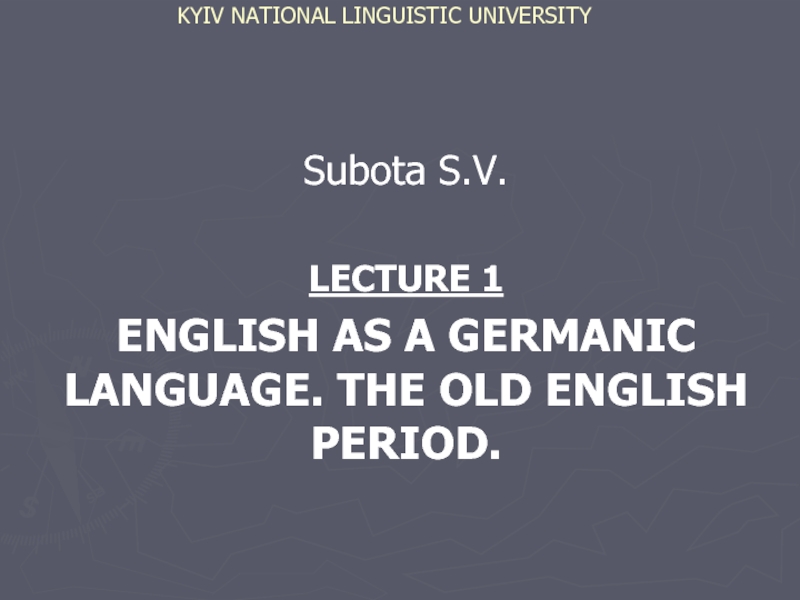
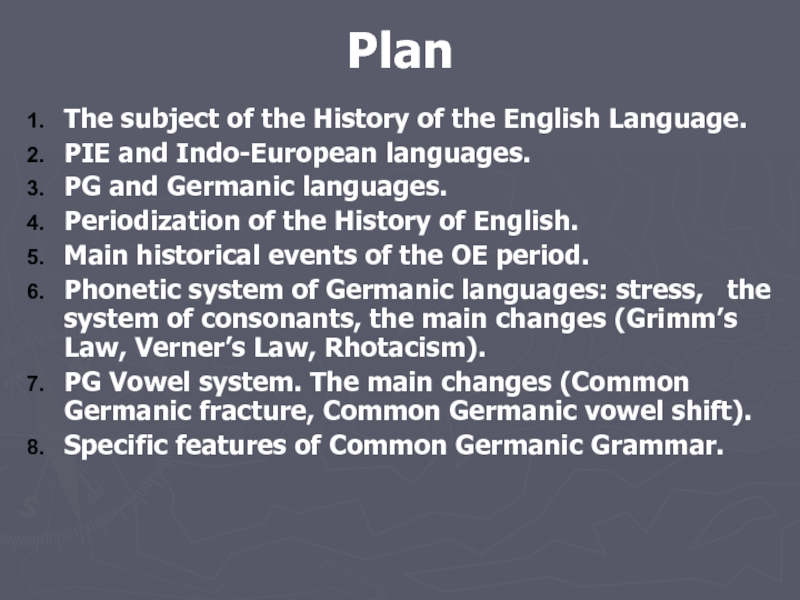
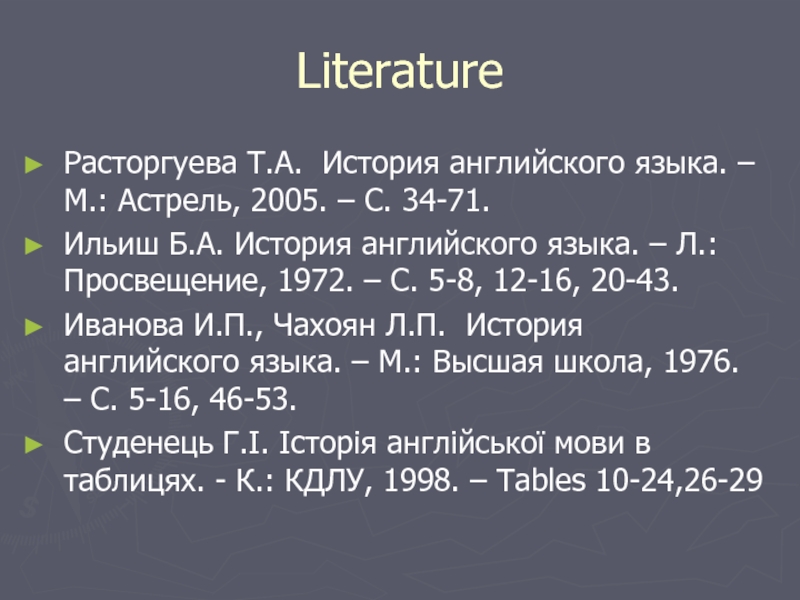
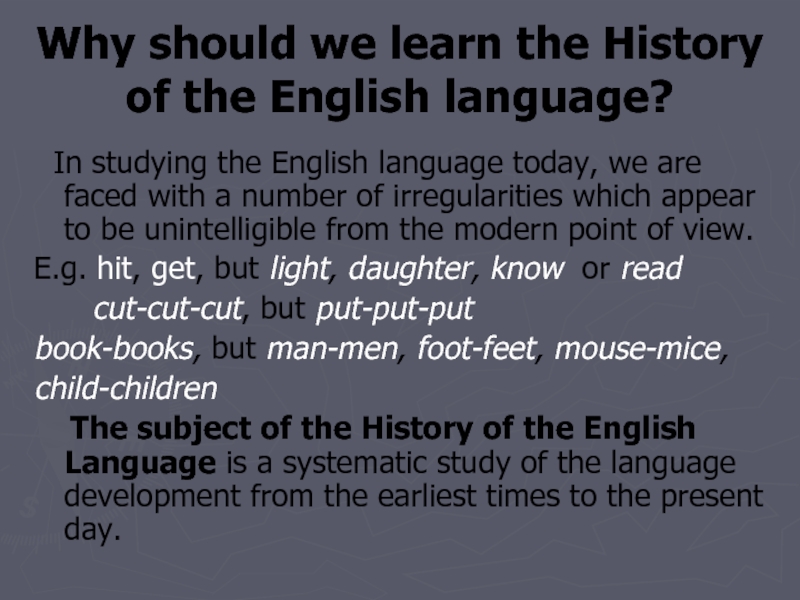
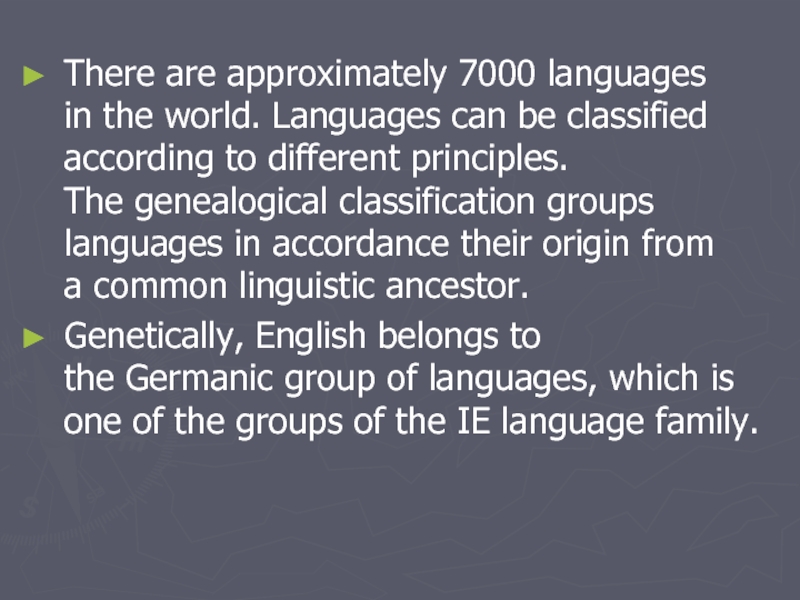
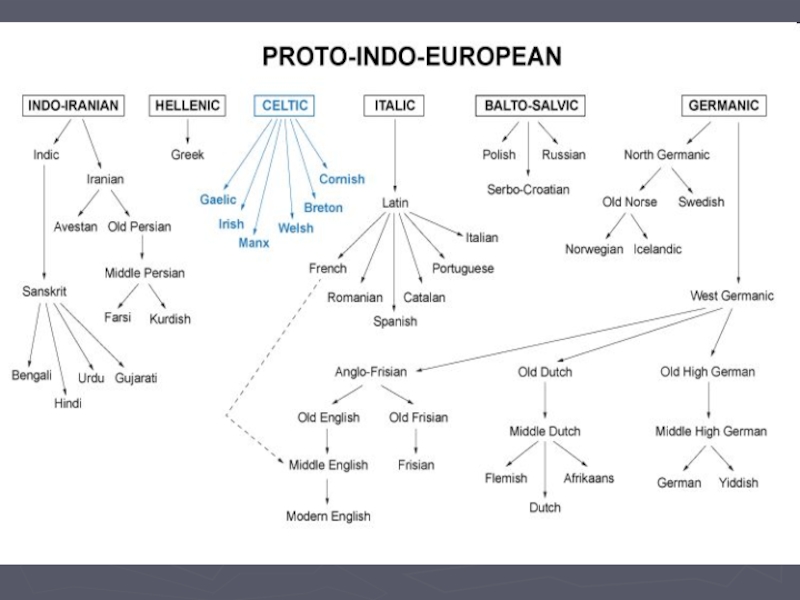

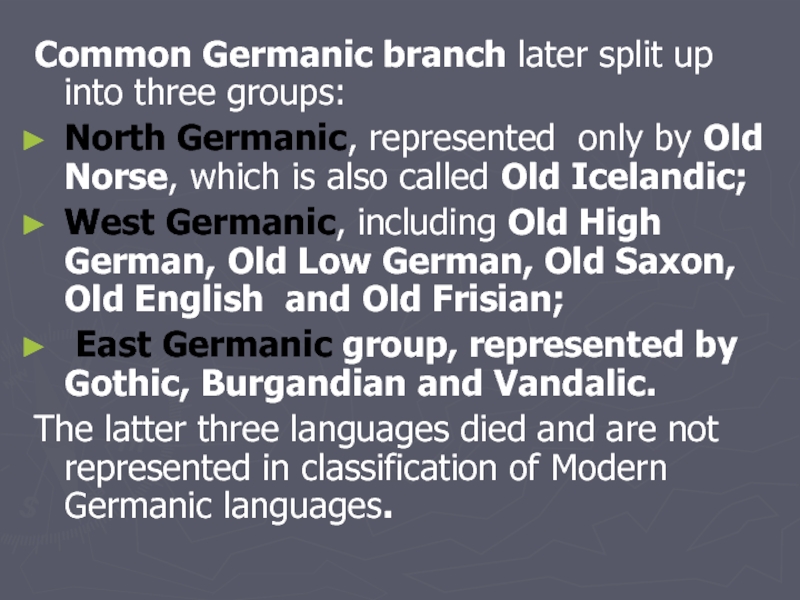
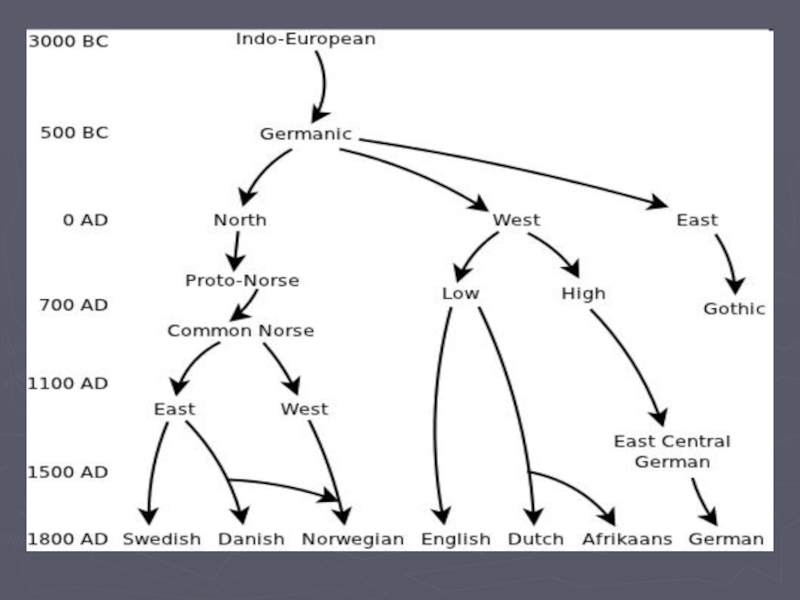
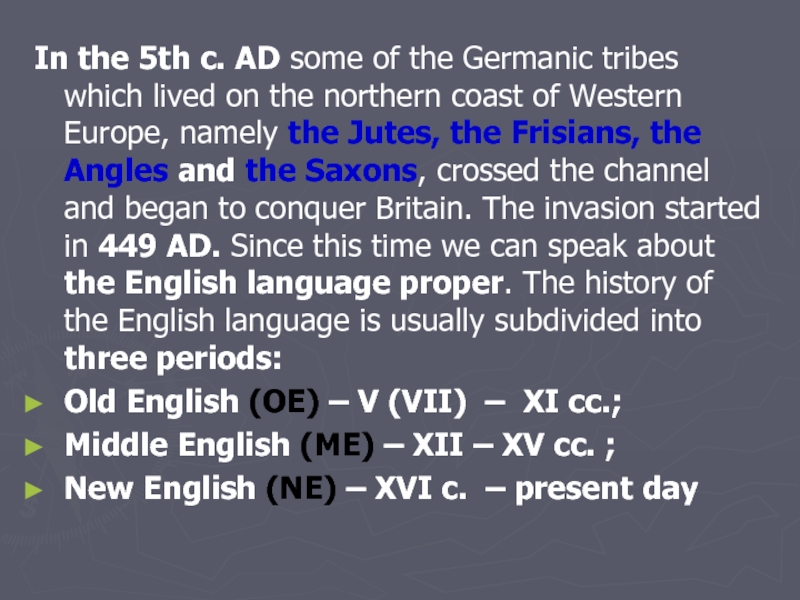
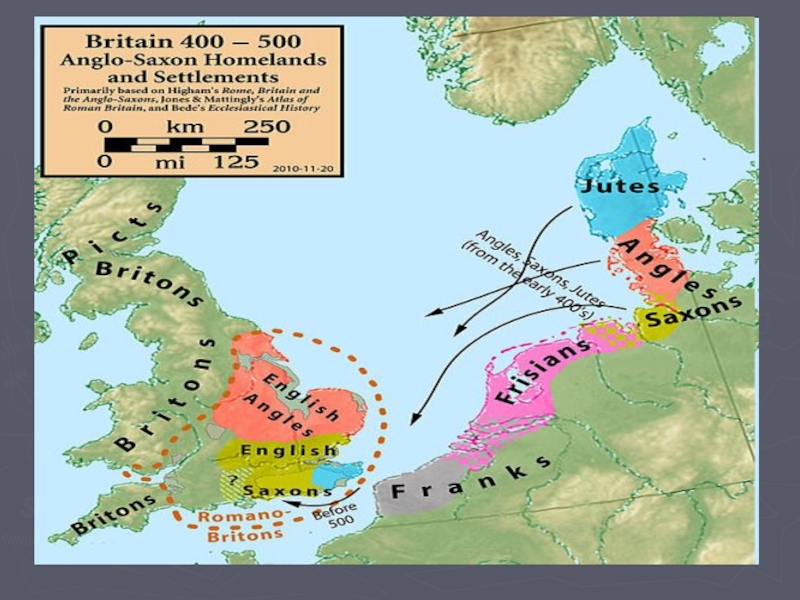
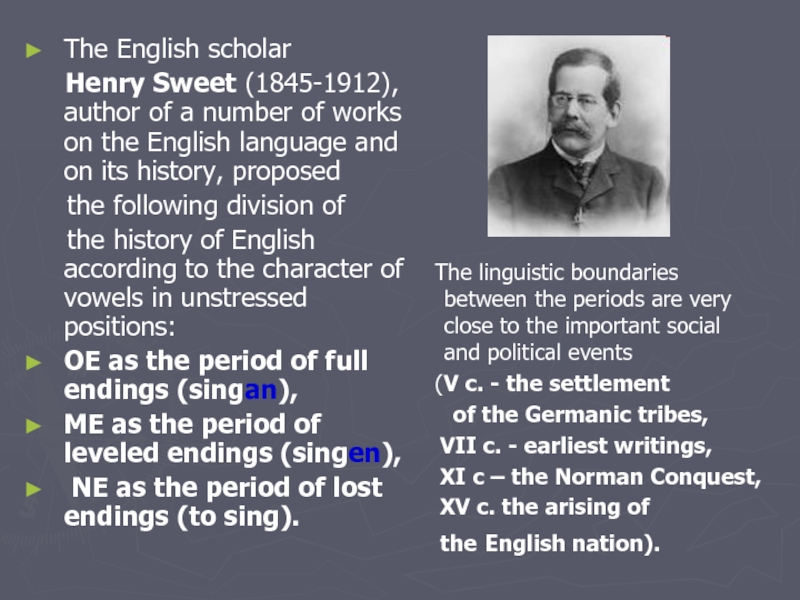
![The Seven Kingdoms of the Heptarchy [ʹhepta:kı]Germanic tribes formed in Britain seven kingdoms: the Jutes](/img/tmb/2/123953/a62d03a7a39499ab20ae12c6714969ad-800x.jpg)


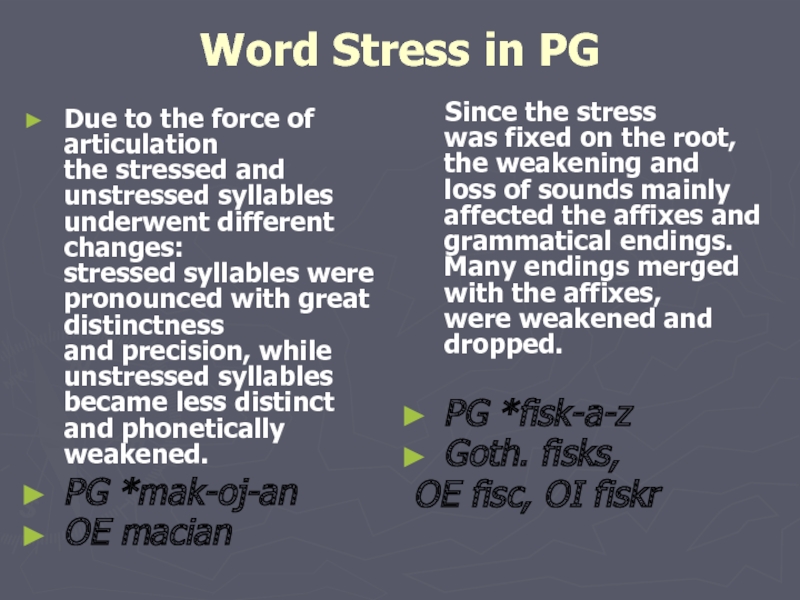
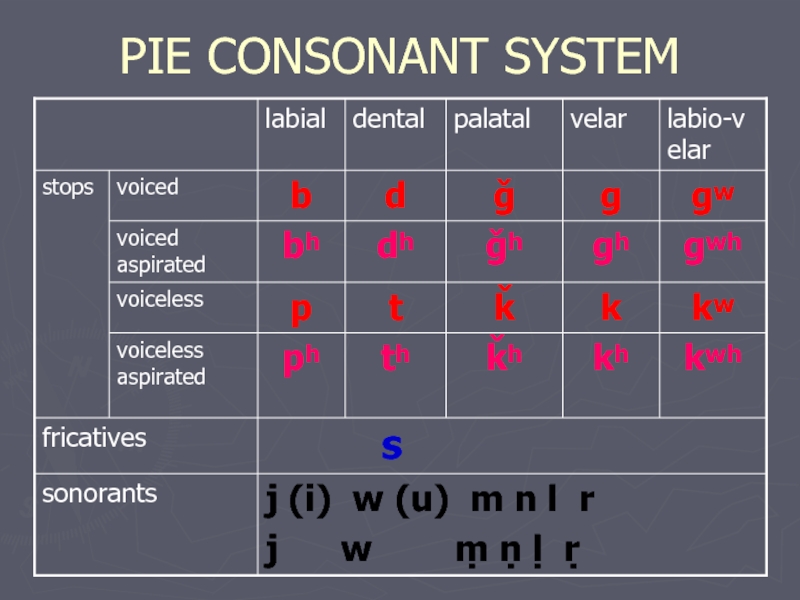
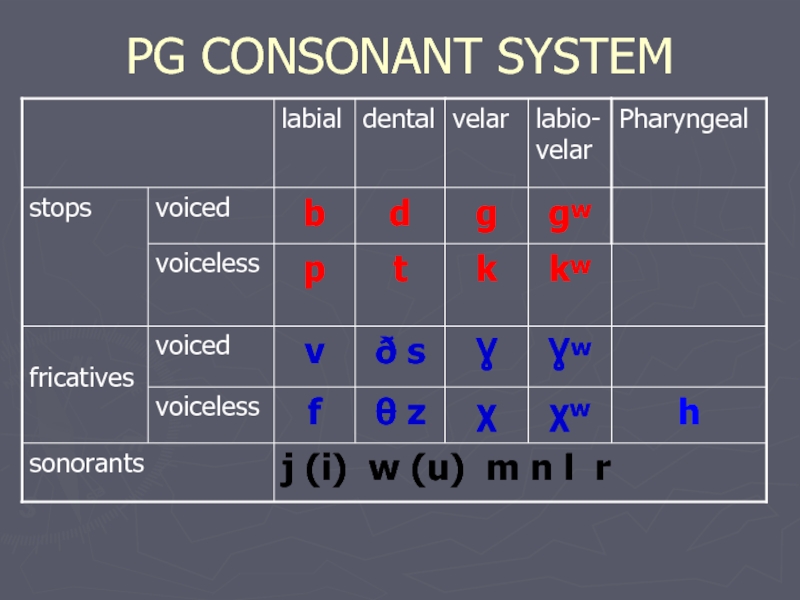

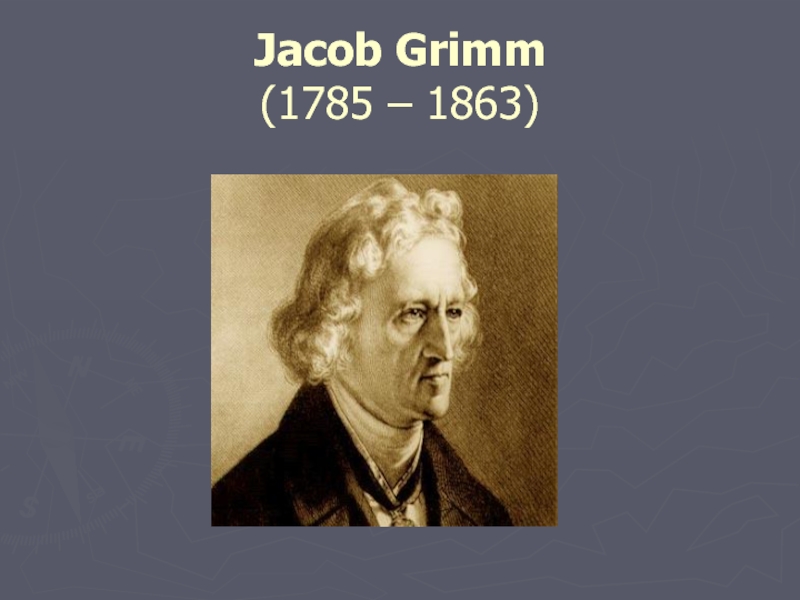
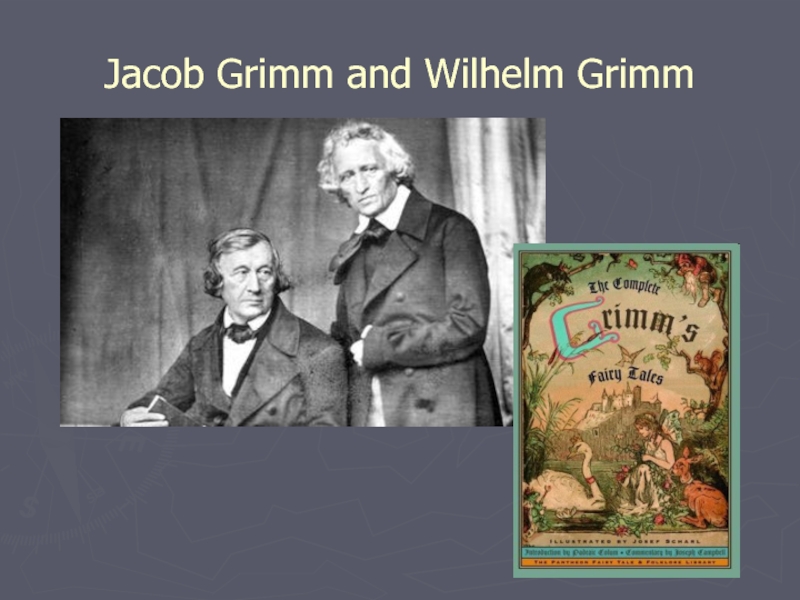

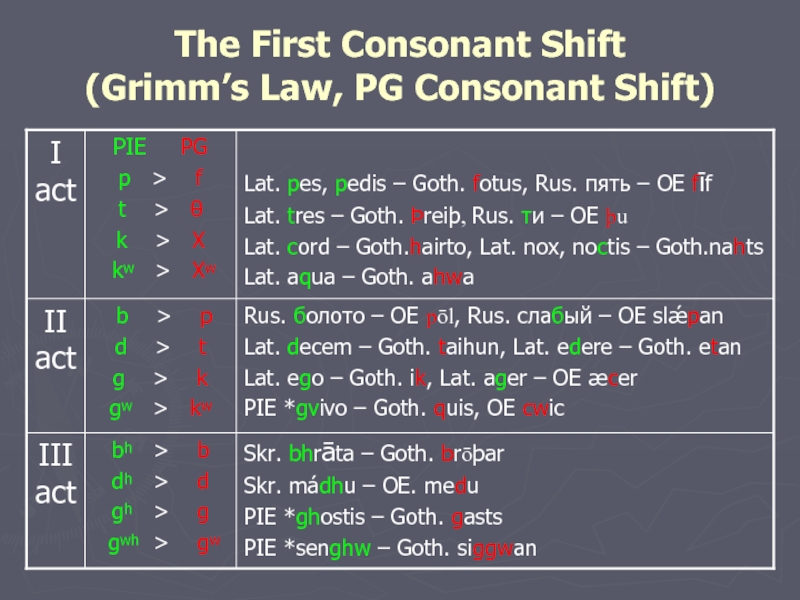
![ExceptionsA PIE voiceless plosive followed the voiceless fricative [s]:Lat. stella → Eng. star, Rus. гость](/img/tmb/2/123953/0055f54cee9e89a7d9196fb036c5c0ff-800x.jpg)
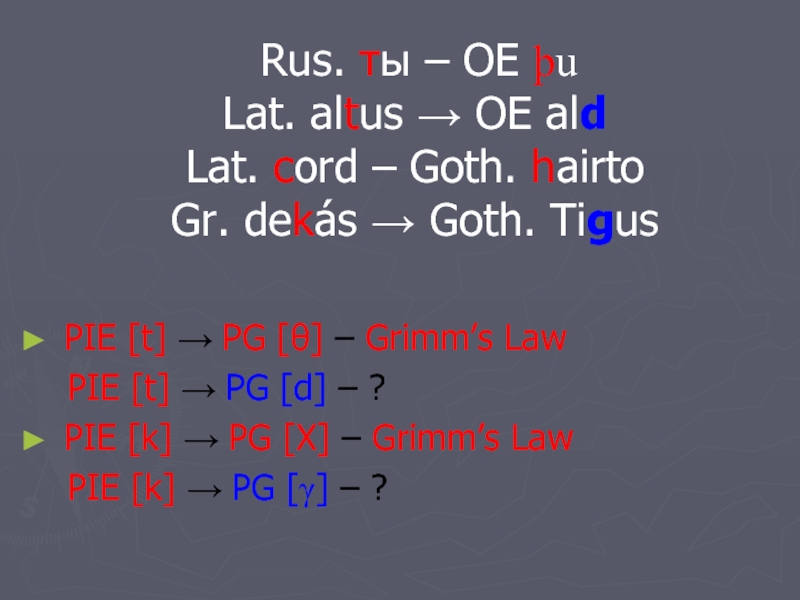
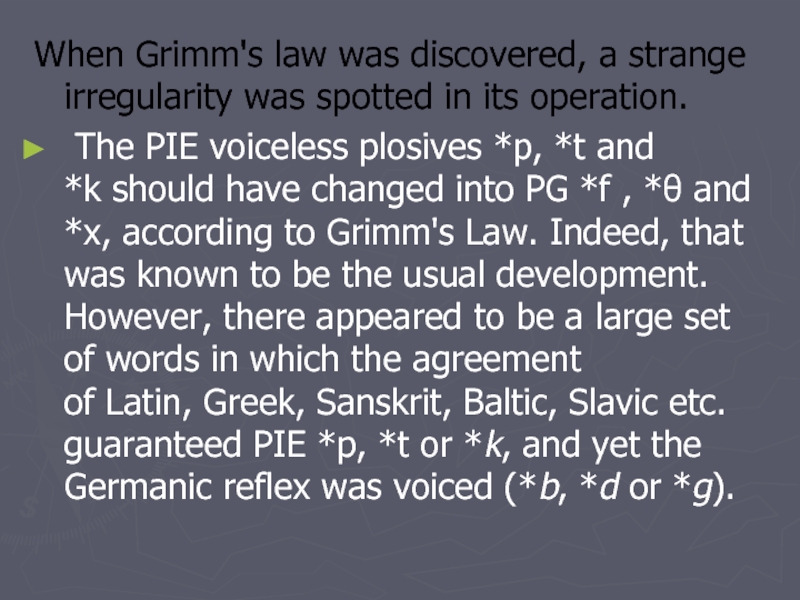
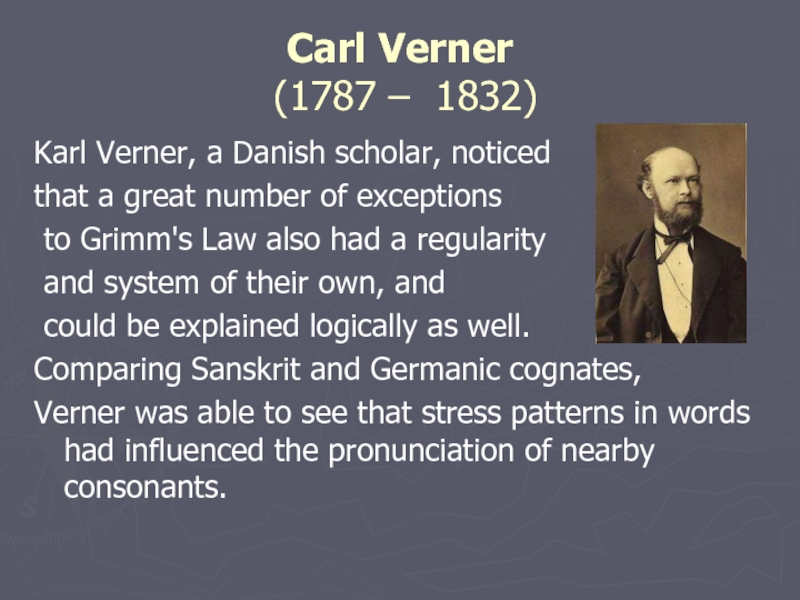


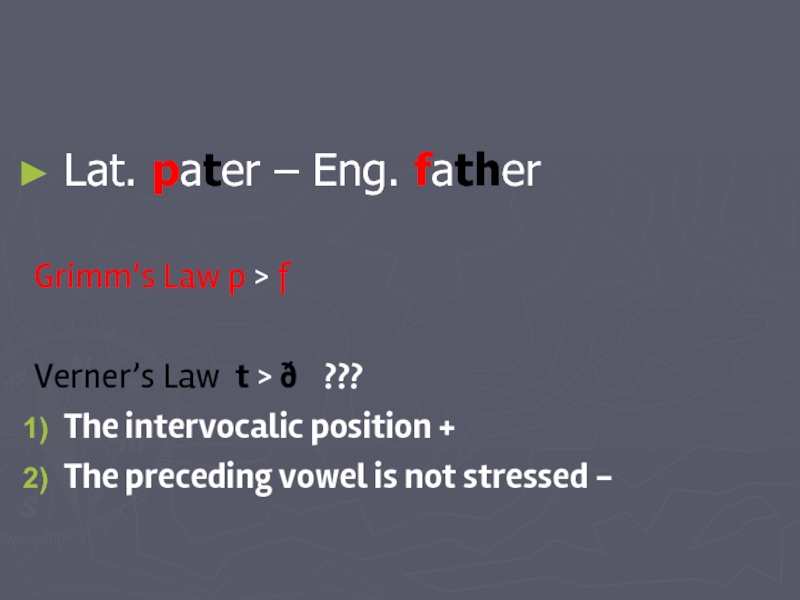

![Verner’s law accounts for the appearance of the voiced fricative [р] or its later modifications](/img/tmb/2/123953/1ecb7d843ed8e659011c27514a415c6f-800x.jpg)


















